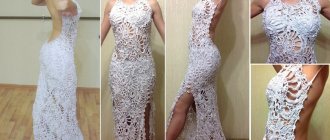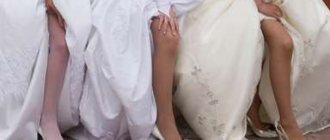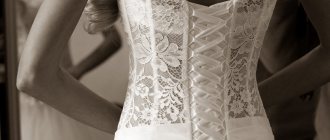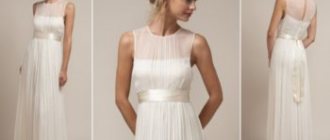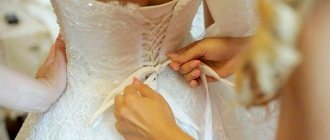A wedding dress can easily become wrinkled and lose its presentable appearance. This occurs due to improper transportation or improper storage after trying on and wearing. Products become especially wrinkled and dirty after busy wedding days.
It is important to ensure proper care of your clothes, because thin and delicate fabrics can be damaged by the iron or steamer and the high temperature of ironing. Let's look at how to properly steam a wedding dress at home. Let's learn how to iron an outfit before a wedding or iron a product after an important event.
Mechanical steaming methods
There are several ways to steam clothes. The simplest is to use an iron with a vertical steamer function, a handheld steamer or a steam generator. By the way, the last two devices most effectively smooth the fabric, completely removing folds and wrinkled areas.
To steam, fill the device with water and heat to minimum temperature. Hang the dress on a hanger and steam the items at some distance from the surface until the fabric is completely smooth. Straighten the material with your hands as you go. Therefore, it is better to perform this procedure together. While one person straightens the fabric, the other will steam.
Steamers and steam generators straighten the material quickly and efficiently. The procedure takes no more than 20 minutes. They can easily cope with even the most difficult folds and dents, the smallest creases.
Make the surface perfectly smooth. The devices are suitable for delicate and thin fabrics, items with frills, beads, embroidery and other decorations, which is extremely important for a wedding dress.
In addition, steamers and steam generators clean clothes and eliminate germs, viruses and dust mites from the surface of materials. However, not everyone can afford this pleasure. In this case, you can use the traditional method of steaming using steam and boiling water.
How to steam?
There are several options for steaming a dress at home: steam, a steamer, and an ordinary iron with wet gauze.
To rid your wedding outfit of bumps using steam, you first need to fill the bathtub with hot water. The dress is placed on hangers and then placed above the water at a height of twenty-five centimeters. After the wrinkles are smoothed out, you need to hang it out for three to four hours so that it dries completely. How long it will take for the outfit to iron out depends on the density of the fabric. This method has some disadvantages:
- When steam penetrates the fibers of the fabric, it becomes heavier, absorbing a large amount of moisture. This may cause the dress to fall into the water. Care must be taken to ensure that this does not happen.
- If the outfit has an abundance of different rhinestones, it is better not to use this method, as they may come off.
- This method is a bad option for dresses made of heavy material, as well as for dresses with fluffy multi-layered skirts.
Steaming and boiling water
Pour boiling water into the bath and hang the dress on a hanger above the water. It is important that the hem hangs at a height of 20-30 centimeters from the water. Due to the steam, the fabric is gradually smoothed and straightened. Make sure that the outfit does not fall into boiling water!
In addition, prolonged exposure to steam may cause rhinestones, beads and other decorative elements to fall off. Therefore, it is not recommended to leave products in the bathroom for a long time.
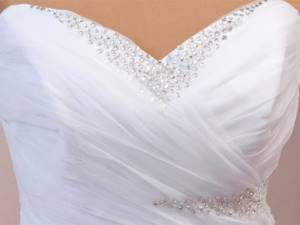
Instead of a bath, you can use a saucepan or other similar container. Fill the container with boiling water and hang the dress over it. Smooth out the material with your hands, straighten out folds and creases. This method is most suitable for smoothing a veil.
However, here you need to be careful and not overdo it. Products should not touch water or be exposed to steam for too long, otherwise the delicate fabric will become deformed and deteriorate.
In addition, you can order a steaming service from a professional dry cleaner or directly from a wedding salon. Large stores provide this service when purchasing an outfit for little money.
Is it possible to iron a wedding dress?
You can iron a wedding dress if the label on the garment allows it. If you have washed the product, do not wring out the fabric under any circumstances! Wait until the dress is dry and then proceed with the procedure. You can iron a wedding dress only with a clean soleplate without soot, scale, stains or burnt areas. The product is ironed from the wrong side!
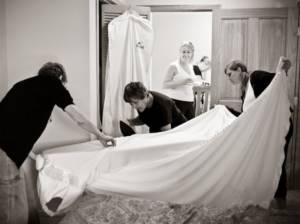
The temperature and ironing process depend on the type of fabric. As a rule, for delicate and synthetic materials, the heating of the iron should not exceed a minimum temperature of 100-110 degrees. If the dress consists of different fabrics, the appropriate temperature is selected for each material.
Silk and veil, lace dress and lace elements are ironed exclusively through gauze or natural fabric only from the wrong side at a minimum heating temperature without the use of steam. Satin is also ironed from the inside out at a minimum temperature, but with a steamer. Polyester can be ironed at an average temperature of up to 150 degrees without a steamer.
It is not advisable to iron organza, tulle and chiffon. After washing and after the water has drained, the items are hung on a hanger. The material is carefully straightened and left to dry in public conditions. Do not dry a wedding dress near or on a radiator or heating appliances, or under direct exposure to sunlight!
When drying vertically, thin organza, chiffon and lush tulle straighten on their own without an iron. If wrinkles or bruises have formed, straighten the areas by weight.
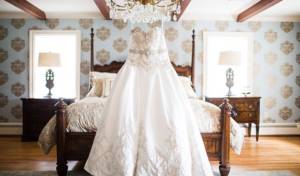
As a last resort, items made of chiffon and organza are ironed through silk or tissue paper at a minimum temperature without steam. And how to restore the fullness of a tulle skirt, read the link.
How to iron a wedding dress correctly
- First, place a white or light terry sheet or other similar fabric on the ironing board;
- The dress is turned inside out and laid out on an ironing board;
- The material is straightened and covered with gauze or natural fabric on top. Gauze and thin fabric are folded in several layers;
- First of all, iron the bodice and corset, and then move on to the sleeves (if any), to the skirt and decorative details;
- Sleeves are ironed on a special stand, which is provided by each ironing board. To prevent them from becoming wrinkled after ironing, you can put rolled sheets of white paper in the sleeves;
- Voluminous and multi-layered skirts need to be ironed gradually, starting from the bottom layer. In each case, be sure to use gauze;
- Each decorative element is ironed and processed separately, taking into account the fabrics. Adjust the iron setting for each type of material;
- To iron the product without harming the fabric and accessories, you need to iron it carefully and carefully using smooth movements;
- Do not press the sole too hard into the material or linger in one area.
After steaming or ironing, leave the product on soft hangers at room temperature for two hours. Only then put it in the closet. It is important to choose a storage place where the hem does not rest against the bottom, but hangs freely.
The skirt should be straightened, and the outfit itself should hang vertically. In addition, there should be a dark place as wedding fabrics do not like exposure to light and sunlight.
Using an iron
Ironing a wedding dress is an economical option and very labor-intensive. Ironing is difficult to do on your own; you will have to ask your mother or friend for help.
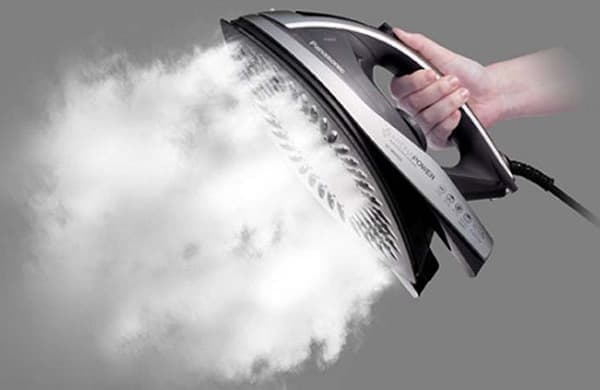
Do not iron parts decorated with beads, rhinestones and sequins.
Everything will go smoothly if you follow simple instructions.
Remember that you won't be able to reach every place with an iron to make your outfit look perfect. That's why wedding dresses are steamed in salons. Such devices remove all creases and folds, taking a minimum of time and effort.
In addition, if you use a steamer, you will not need the help of others.
How to iron a dress correctly:
- If stains are found, it needs to be washed.
- Ironing begins with the bodice. This part of the outfit is usually decorated with various decorations, so the process is carried out from the wrong side. If there are laces at the back, remove them. If the bodice has a zipper, unzip it. The bodice without decoration can be ironed from the outside.
- Creases and crumpled places need to be moistened. This will make it easier to smooth them out. Fill a spray bottle with distilled water and spray the material if necessary.
- Ironing is done through gauze. The soleplate of the iron should not be applied to delicate fabric, as it may burn a hole.
- After ironing the bodice, move on to the petticoat. If there are several of them, process them one by one. Lastly, the top layer is smoothed out.
- If there is a train, iron it on both sides. Use gauze lightly moistened with water from a spray bottle.
- The work is completed by treating the outfit with an antistatic agent. Read the instructions for its use and spray at a distance of 20–30 cm from the dress.
Consider the material from which the dress is made. It may be made from several fabrics, which means that the temperature on the iron will have to be constantly adjusted so as not to ruin the outfit.
After finishing ironing, do not put it on the bed. Hang it on your hanger. You can't go into the closet. The dress will wrinkle again. It’s good if it is possible to hang it in such a way that there is nothing within a few centimeters around it and no one walks there.
Chiffon
Chiffon wedding dresses are ironed at a temperature of 60–120 degrees. Modern technology has programs that are already adapted to the required material. Just choose the “delicate” or “chiffon/silk” mode and calmly iron the desired areas.
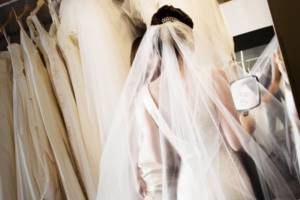
Dresses made from this material look great if ironed correctly.
This fabric also easily deteriorates if you turn on the wrong ironing mode.
It is not recommended to use steamers for wedding dresses made of this material. Typically, the manufacturer indicates this information on the label.
It is much easier to iron clothes when wet. Use a spray bottle, just don't overdo it. If you wet it too much, you will have to iron it longer, and the hot temperature with prolonged exposure harms the material.
Before ironing, turn the product inside out and place it on the ironing board. The iron should slide smoothly from the central part to the edges, this way you can avoid the formation of creases in the material.
Atlas
Satin fabric does not require special care. Perhaps dresses made from this material are the easiest to iron and steam.
How to iron a wedding dress made from this fabric:
- Satin cannot be ironed at temperatures above 150 degrees. It should be processed exclusively from the reverse side to preserve the shine and unsurpassed appearance of the material.
- It is recommended to use cotton cloth for ironing. You cannot apply the iron sole of the iron directly to the fabric unless you want to damage it on purpose. In addition, cotton fabric will protect the satin from glossing.
- Do not iron dry satin. Before the procedure, it is well moisturized.
If for some reason there is an iron mark on your outfit, soak a cotton cloth in a vinegar solution and apply it to the problem area. Then steam the area with the iron, but do not iron.
Lace
Lace inserts need to be starched with a weak solution of potato starch. Mix 2 tbsp in a container. l. products and 5 liters of water.
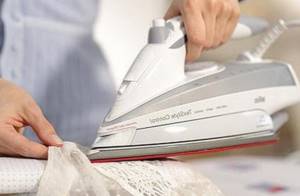
The product is starched with this mixture, then dried a little, after which you can begin ironing. The procedure is carried out only with the tip of the iron, carefully moving it over the fabric.
The lace should be ironed very carefully so as not to create creases or wrinkles at the edges. Watch your movements carefully; the tip of the technique can tear the material.
Ironed and starched fabric looks better than steamed fabric.
